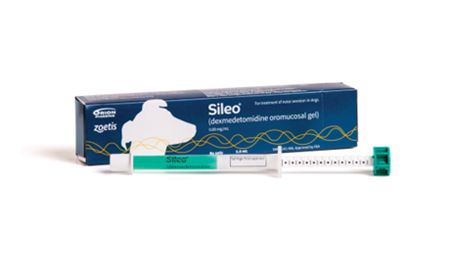Zoetis launches non-sedative calming gel to treat noise aversion in dogs
Sileo, designed for pet owners to administer before or at the time of a fear or anxiety-eliciting noise stimulus, is the first FDA-approved treatment specifically for noise aversion.
For many dog owners, summertime isn't all about fun in the sun. Fireworks, storms, parties and even construction work-all of which can negatively affect dogs with noise phobia-means that warmer weather can make for a frequently scared, anxious pet. Noise phobia is a dog's sudden and profound, sometimes extreme response to noise, manifested as intense, active avoidance; escape; or anxiety behaviors.

Zoetis recently announced the launch of Sileo (dexmedetomidine oromucosal gel), the first and only medication approved by the U.S. Food and Drug Administration (FDA) for treatment of noise aversion in dogs, according to a company release. Veterinarians can now prescribe Sileo, which can be safely administered at home by pet owners to help calm dogs without causing sedation during noise events.
Sileo is administered via oral transmucosal absorption, which limits the amount of dexmedetomidine available in the body at any given time after administration, allowing dogs with noise aversion to remain calm yet fully functional. Sileo has a rapid speed of onset, typically taking effect within 30 to 60 minutes after application. This way, it can be tailored to the timing and duration of the noise event, such as a storm, according to the company release.
“We know that noise aversion has been difficult to treat, is stressful for pet owners and can be traumatic for their dogs. Sileo works the way veterinarians and pet owners need it to work, calming dogs while allowing them to interact normally with the family,” said Shelley L. Stanford, DVM, MS, MBA, group director, Companion Animal Veterinary Professional Services at Zoetis. “It has rapid speed of onset, is easy to administer at home and works ‘in the moment,' without any other treatments or training.”
Common clinical signs of noise aversion include trembling, panting, cowering, and escape behavior. Additional signs of noise phobia include salivation, defecation, urination, vocalization, and destruction of property. Veterinary behaviorists acknowledge that fearful, anxious and distressed pets can disrupt the human-animal bond.
“There is no suffering and pain worse for dogs than that caused by fear. Fear deprives dogs of joy and damages relationships,” says Karen L. Overall, MA, VMD, PhD, DACVB, CAAB. “Fear of noises may affect almost half of all dogs in their lifetimes. It is one of the most common co-morbid canine behavioral conditions, and it worsens other behavioral conditions. Behavioral pathology is progressive, so early recognition, diagnosis and treatment are essential. Every effort to minimize or mitigate fearful states is essential to humane care.”
Veterinarians prescribe Sileo in a 3 mL high-density polyethylene syringe, equipped with a dosing ring and end cap and packaged in a cardboard box. The dosage is 125 mcg/m2. It is administered by placing the gel between the dog's cheek and gum and allowing for oral transmucosal absorption. Each dose lasts between two to three hours. Sileo can be re-dosed as needed every two hours, up to five times during each noise event. Adverse reaction rate to Sileo was low, and all reactions were mild, according to the company release.
For important safety information and additional details, visit the Sileo website.
Podcast CE: A Surgeon’s Perspective on Current Trends for the Management of Osteoarthritis, Part 1
May 17th 2024David L. Dycus, DVM, MS, CCRP, DACVS joins Adam Christman, DVM, MBA, to discuss a proactive approach to the diagnosis of osteoarthritis and the best tools for general practice.
Listen